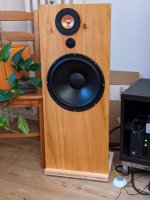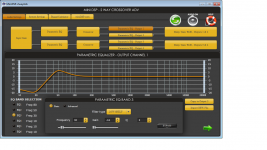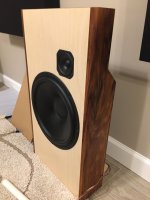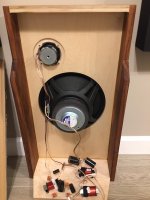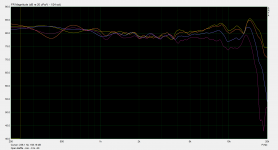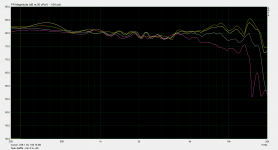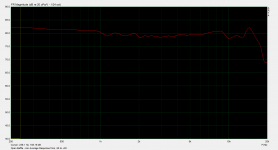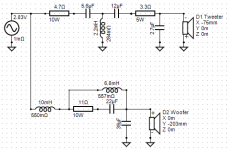Peerless12 VS GRS 15
Hello all from arctic SW Texas! With out question, the Peerless is a better woofer. But, it's original cost nearly doubled, so in keeping with the original design goals, and after trying out several alternatives, the GRS was the best bang for the buck solution I could find in an off the shelf driver.
However, the Peerless cost has more or less held steady while the GRS has slowly and steadily increased. Inflation is with us. So today, the Peerless has become viable again bringing the following advantages:
World wide availability, now cost competitive again. Larger displacement, Faraday cap on pole pice, all rubber surround, better lower mid range, higher efficiency and better overal construction. The GRS has a larger surface area and QTS and is still lower in cost here in the US.
Sonically, when used in the Manzanita, the Peerless sounds better over all, but does not reach down quite as low as the GRS.
Hello all from arctic SW Texas! With out question, the Peerless is a better woofer. But, it's original cost nearly doubled, so in keeping with the original design goals, and after trying out several alternatives, the GRS was the best bang for the buck solution I could find in an off the shelf driver.
However, the Peerless cost has more or less held steady while the GRS has slowly and steadily increased. Inflation is with us. So today, the Peerless has become viable again bringing the following advantages:
World wide availability, now cost competitive again. Larger displacement, Faraday cap on pole pice, all rubber surround, better lower mid range, higher efficiency and better overal construction. The GRS has a larger surface area and QTS and is still lower in cost here in the US.
Sonically, when used in the Manzanita, the Peerless sounds better over all, but does not reach down quite as low as the GRS.
You may find this thread interesting Did Siegfried Linkwitz miss a trick?I'm thinking of doing it as much for the appearance as for the sound. Maybe even more so for the aesthetics.
Theoretically it should make the sound a little better. But I just want to make sure it won't compromise the sound in some obscure way that I didn't anticipate.
Thanks for your feedback.
I´m comparing it to a 15" in a h-frame that I somehow never liked 100%.the Peerless is a better woofer.
The 830669 is a splendid woofer and if you look at other suitable candidates it still is among the cheapest/priceworthiest.
I took my inspiration here to get and try it, so thanks a bunch!
Now I only gotta get another pair or two!
It´s an Alpair 7.3 with a Seas TFFNC/G and 830669 on a prototype baffle of only 36cm width without wings.
Minidsp on the bottom with a slight bass boost and passive XO between A7.3 &Seas.
Attachments
joensd.... Thanks for posting a picture of your OB! If you haven't already, experimenting with some card board wings you can learn a lot about improving the Peerless out put abilities without adding cavity issues. Have you added a trap on the Peerless to tame the break up that is centered at 2 Khz? Just curious... J
I´ll definitely do that and see if it gives me more bass with less effort.experimenting with some card board wings
1x12" can only take so much EQ although it sounds very full I have to say.
At the moment I have a 1st order LP at 140Hz which looked good in Basta but I need to turn the amp up quite a bit to compensate.
Additionaly there is a low shelf involved and a negative gain peak filter to further compensate dipole loss and then bring the response down towards fs.
Measuring speakers in general and especially open baffle bass "in the room" is still puzzling me so I have to work on that before making further conclusions.
It looks though as the 6dB-LP is not getting rid of the dipole peaks so I will try a 2nd order filter next. As you can see in the measurement bass drops quickly after 80Hz although there is substantial output down to 50Hz. Thereafter it drops completely.
At 2k the measurement looks relatively flat. I don´t see anything that looks like a resonance but I measure a lot just from the listening position.
As you can see from the picture, it is inviting to try something Manzanita´ish in the future just using the tweeter and woofer.
Attachments
Hello all from arctic SW Texas! With out question, the Peerless is a better woofer. But, it's original cost nearly doubled, so in keeping with the original design goals, and after trying out several alternatives, the GRS was the best bang for the buck solution I could find in an off the shelf driver.
However, the Peerless cost has more or less held steady while the GRS has slowly and steadily increased. Inflation is with us. So today, the Peerless has become viable again bringing the following advantages:
World wide availability, now cost competitive again. Larger displacement, Faraday cap on pole pice, all rubber surround, better lower mid range, higher efficiency and better overal construction. The GRS has a larger surface area and QTS and is still lower in cost here in the US.
Sonically, when used in the Manzanita, the Peerless sounds better over all, but does not reach down quite as low as the GRS.
Thanks so much 🙂 so Peerless will be
Can you give me an example of what you mean when you say that the tweaking range is 2:1 centered around the nominal value?
The way I'm reading it you are saying there are boundaries in the tweaking so for example:
For the 15 ohm resistor that controls the tweeter level (R2) the 2:1 ratio centered around nominal value...are you saying that the tweaking range should be +/- 50 percent i.e. from a low value of 7.5 to a high value of 22.5 based on the nominal value being 15?
The way I'm reading it you are saying there are boundaries in the tweaking so for example:
For the 15 ohm resistor that controls the tweeter level (R2) the 2:1 ratio centered around nominal value...are you saying that the tweaking range should be +/- 50 percent i.e. from a low value of 7.5 to a high value of 22.5 based on the nominal value being 15?
Here we have the simple and clever crossover that makes this OB speaker work. See below for the 12 and 15 inch versions. Actually, either crossover will work with either woofer, but the versions below have been tweaked for best performance with the different woofers. The big piece is the low pass inductor on the woofer. It can be 18-22mH, default 20mH. Use a 14 gauge iron core inductor. This is available from Erse, Madisound or Parts Express in the USA. This part is relatively expensive, but important to the design. Default part at the moment is Parts Express P/N 266-960 (16 ga. 20 MH)
Capacitor C1 is the high pass filter for the Vifa. R1 is attenuation for the Vifa, while R2 and L2 shape the top end response of the Vifa. Tune the value of R1 to raise or lower the overall output of the Vifa (mids and highs) and tune R2 to change just the levels of the Vifa highs. The tweaking/tuning range of R1 is usually 2:1 centered around the nominal value. R2 tuning range is the same 2:1 ratio around the nominal value. 5-10 watts is enough for these resistors. Default is capacitor is Parts Expres P/N 027-236. You can use 5.5 - 6.5 uF to suit. Look for 200 Volt or higher Poly, film and foil, MKP or Oil construction. NOTE: Connect the Vifa in reverse polarity.
Please be prepared to tweak and tune these values to suit your room acoustics and your speaker placement. The overall level as well as the slope of the Vifa response need to be tweaked for your situation. Take your time, start with the default and tune it for you room.
In series with the woofer will you see an optional woofer trap. This helps tame some come breakup of the woofer. It's a nice addition. The same trap works for either woofer.
EDIT: Now that these are posted, I will add some detail to the posts.
Yes. Those are suggestions for tweaking. +/- 50%. You likely won't need to go outside those limits. But you do need to tune for your room, and maybe for your ears. E.G. John likes the tweeter louder than I do, but it's not a matter of much difference.
Yup, that makes total sense!
Unfortunately COVID has hosed production so that some of that parts (the 4.7mh inductor) are getting harder to come by.
I also prefer the tweeter a little less loud as well.
Unfortunately COVID has hosed production so that some of that parts (the 4.7mh inductor) are getting harder to come by.
I also prefer the tweeter a little less loud as well.
OB Project
Hi All,
Thought I share my build (not complete just yet).
I love the look of the Manzanitas......and so I went with the slightly less-deep frame around the Mid/Tweeter. I also recessed the Mid/Tweeter. Although it was annoying to do so, I do like the aesthetics with it flushed.
This build was completed with only the scrap wood I had on hand. The baffle is 3/4" Baltic Birch plywood. The side frames are made from solid 3/4" Hawian Koa (from a busted side table we hand on hand). The top and bottom are again 3/4" Baltic Birch ply, but I veneered the top with a scrap teak veneer (I ran out of Koa).
Considering this thread promotes experimenting, I decided to take my own stab at designing the crossover. To be clear, my crossover is in NO WAY an improvement, it's simply just catered to my taste. Some measurements included below. If people are interested, I'll gladly post the schematics and the exact dimensions used for my build.
All measurements were on the Mid/Tweeter axis, centered on the baffle, mic distance @ 1m (although the crossover was developed assuming 2m listening distance). Window: 4ms, Smoothing: 1/24th
Hi All,
Thought I share my build (not complete just yet).
I love the look of the Manzanitas......and so I went with the slightly less-deep frame around the Mid/Tweeter. I also recessed the Mid/Tweeter. Although it was annoying to do so, I do like the aesthetics with it flushed.
This build was completed with only the scrap wood I had on hand. The baffle is 3/4" Baltic Birch plywood. The side frames are made from solid 3/4" Hawian Koa (from a busted side table we hand on hand). The top and bottom are again 3/4" Baltic Birch ply, but I veneered the top with a scrap teak veneer (I ran out of Koa).
Considering this thread promotes experimenting, I decided to take my own stab at designing the crossover. To be clear, my crossover is in NO WAY an improvement, it's simply just catered to my taste. Some measurements included below. If people are interested, I'll gladly post the schematics and the exact dimensions used for my build.
All measurements were on the Mid/Tweeter axis, centered on the baffle, mic distance @ 1m (although the crossover was developed assuming 2m listening distance). Window: 4ms, Smoothing: 1/24th
Attachments
Last edited:
Very nice! Thanks for the photos and the graphs, that's a very clean build. Neat work on the tweeters. Geez, with the price of koa these day you probably could have sold those planks and financed the whole project. 😀
Very nice! Thanks for the photos and the graphs, that's a very clean build. Neat work on the tweeters. Geez, with the price of koa these day you probably could have sold those planks and financed the whole project. 😀
Thanks, Pano. You are correct on the price of Koa. A while back I had purchased a whole living room set made of solid Koa (no veneer - solid Koa). The previous owner had it built in 1962 while stationed in the Navy in Hawaii. All pieces were in good shape with the exception of this one side table. The table top was just enough in length and width to cut the 4 side pieces.
Hi All,
Thought I share my build (not complete just yet).
I love the look of the Manzanitas......and so I went with the slightly less-deep frame around the Mid/Tweeter. I also recessed the Mid/Tweeter. Although it was annoying to do so, I do like the aesthetics with it flushed.
This build was completed with only the scrap wood I had on hand. The baffle is 3/4" Baltic Birch plywood. The side frames are made from solid 3/4" Hawian Koa (from a busted side table we hand on hand). The top and bottom are again 3/4" Baltic Birch ply, but I veneered the top with a scrap teak veneer (I ran out of Koa).
Considering this thread promotes experimenting, I decided to take my own stab at designing the crossover. To be clear, my crossover is in NO WAY an improvement, it's simply just catered to my taste. Some measurements included below. If people are interested, I'll gladly post the schematics and the exact dimensions used for my build.
All measurements were on the Mid/Tweeter axis, centered on the baffle, mic distance @ 1m (although the crossover was developed assuming 2m listening distance). Window: 4ms, Smoothing: 1/24th
Congratulations on a very nice build.
Manzanita is on my short list to build soon, and I'd like very much to see your plans and crossover details.
It looks like you have about a 3/4" round over on the front edges and that's what I have in mind as well.
But mostly I would appreciate your opinion on extending the side pieces all the way to the floor instead of using a stand. When I raised that possibility previously, Pano or John (can't remember which one) had some concerns about how it would effect the bass. Not major concerns, but something that might require some additional tweaking.
Crossover
Sure - see crossover pic.
The crossover was optimized for 10/15 degrees off-axis. The crossover point is approximately 850hz. With the relative close listening proximity for my area, I like the tweeters/mid on the outside.
If you want to bring the top end (i.e. greater than 5khz) down a little bit, you can try the capacitor value of 3.0uf or 3.3uf, in lieu of the 2.7uf. Doing so will move the electrical/impedance phase angle towards 45 degrees, but I personally don't think it's a concern considering the impedance remains above 10ohm (and almost above 15ohm in the concerned area).
While the measurements above indicate a slight frequency response depression (1db - 1.5db) in the 1.25Khz - 4.0Khz range, it is also the same range where tweeter/mid dispersion is at its widest (within its operating range). So there is plenty of 1.25Khz - 4.0Khz energy in the room. Designing for it to be perfectly flat made the speaker sound a little forward for my taste.
Also, the tweeter/mid naturally has a rising response (above, say, 5Khz) when listening on-axis (directly in front of the speaker). I've only slightly tamed this rising response because it drops off very quickly off-axis due to the natural dispersion of the driver.
I used 18AWG inductors, but if you care for more bass-bump, feel free to use a lower AWG. All parts were purchased from Erse 🙂 I'm one of the lucky few here that can't hear the difference between budget / moderately priced capacitors and the top-of-the-line stuff. I wouldn't want to discourage anyone from using premium parts on the crossover, but one should still consider testing out with budget components to confirm the sound works for their taste (before investing top dollar). I believe my crossover cost was approximately $80 (total, for the pair).
In regards to your concern about extending the sides down to the floor, I (personally) don't think there is anything to worry about....at all.....as long as you are simply extending the sides and not the entire baffle itself. Doing the latter may warrant some crossover tweaks, but I don't think any adjustment would be necessary if you are simply extending the sides (even if you double/triple the width of the sides below the speaker for added stability).
Dimensions:
Height = 685mm (27")
Width = 380mm (15")
Edge Roundover Radius = 12mm (approximate 1/2")
Woofer location = 330mm (13") from baffle bottom, centered accross width
Tweeter/Mid location = 152mm (6") from baffle top, 75mm off baffle center
Sides width around woofer = 125mm (just shy of 5" - which is all the wood I had left)
Sides width around mid/tweeter = 73mm (2 7/8")
Cheers
Sure - see crossover pic.
The crossover was optimized for 10/15 degrees off-axis. The crossover point is approximately 850hz. With the relative close listening proximity for my area, I like the tweeters/mid on the outside.
If you want to bring the top end (i.e. greater than 5khz) down a little bit, you can try the capacitor value of 3.0uf or 3.3uf, in lieu of the 2.7uf. Doing so will move the electrical/impedance phase angle towards 45 degrees, but I personally don't think it's a concern considering the impedance remains above 10ohm (and almost above 15ohm in the concerned area).
While the measurements above indicate a slight frequency response depression (1db - 1.5db) in the 1.25Khz - 4.0Khz range, it is also the same range where tweeter/mid dispersion is at its widest (within its operating range). So there is plenty of 1.25Khz - 4.0Khz energy in the room. Designing for it to be perfectly flat made the speaker sound a little forward for my taste.
Also, the tweeter/mid naturally has a rising response (above, say, 5Khz) when listening on-axis (directly in front of the speaker). I've only slightly tamed this rising response because it drops off very quickly off-axis due to the natural dispersion of the driver.
I used 18AWG inductors, but if you care for more bass-bump, feel free to use a lower AWG. All parts were purchased from Erse 🙂 I'm one of the lucky few here that can't hear the difference between budget / moderately priced capacitors and the top-of-the-line stuff. I wouldn't want to discourage anyone from using premium parts on the crossover, but one should still consider testing out with budget components to confirm the sound works for their taste (before investing top dollar). I believe my crossover cost was approximately $80 (total, for the pair).
In regards to your concern about extending the sides down to the floor, I (personally) don't think there is anything to worry about....at all.....as long as you are simply extending the sides and not the entire baffle itself. Doing the latter may warrant some crossover tweaks, but I don't think any adjustment would be necessary if you are simply extending the sides (even if you double/triple the width of the sides below the speaker for added stability).
Dimensions:
Height = 685mm (27")
Width = 380mm (15")
Edge Roundover Radius = 12mm (approximate 1/2")
Woofer location = 330mm (13") from baffle bottom, centered accross width
Tweeter/Mid location = 152mm (6") from baffle top, 75mm off baffle center
Sides width around woofer = 125mm (just shy of 5" - which is all the wood I had left)
Sides width around mid/tweeter = 73mm (2 7/8")
Cheers
Attachments
Last edited:
So it looks like you built it according to the original plans, 15"w x 27"h, but are using it resting directly in the floor without a stand.
That would put the mid/tweeter at about 21" above the floor rather than at a typical listening height of about 36". I would also put the woofer much closer to the floor than I think is recommended with this speaker.
Is that the case, and if so, do you think it compromises the sound or not?
That would put the mid/tweeter at about 21" above the floor rather than at a typical listening height of about 36". I would also put the woofer much closer to the floor than I think is recommended with this speaker.
Is that the case, and if so, do you think it compromises the sound or not?
Sorry, I’m using the speaker on 18” (or 16” - can’t remember) stands. The pictures was just to show what they look like, but not in their actual listening space.
I would not recommend putting the speakers on the floor - which is in agreement with Pano/John’s recommendation. Nor would I have them so close to the back wall (as in the picture above). I would definitely follow Pano/John’s placement recommendations.
I would not recommend putting the speakers on the floor - which is in agreement with Pano/John’s recommendation. Nor would I have them so close to the back wall (as in the picture above). I would definitely follow Pano/John’s placement recommendations.
Last edited:
OK. That all makes sense now. Thanks.
One more question. What type of smoothing was applied to the FR graphs that you showed.
One more question. What type of smoothing was applied to the FR graphs that you showed.
Last edited:
Thanks for sharing
Hello Dkalsi.... Thanks for sharing your Manzanita experience! Interesting to see your alternitive crossover and measurememts. Looks quite nice. When we started this post we thought we would see more alternative crossover designs turn up. Suspect there are few out there, but very few shared. Appreciate you posts. J
Hello Dkalsi.... Thanks for sharing your Manzanita experience! Interesting to see your alternitive crossover and measurememts. Looks quite nice. When we started this post we thought we would see more alternative crossover designs turn up. Suspect there are few out there, but very few shared. Appreciate you posts. J
- Home
- Loudspeakers
- Multi-Way
- Fast, fun, Inexpensive OB project
